I got several LEXXA 7W LED-VARAVALO bulbs in hoping to replace some aging LED light bulbs with new ones that have a bonus feature: They have an internal battery that allows them to output light even when the mains power is turned off. Those were available cheaply from Finnish shop Motonet (bulbs with pretty similar look and similar features are also in Amazon).
The marketing promise is good: LED bulbs with integrated lithium-ion battery can provide up to 5 hours lighting during blackout and power outage. White LED light bulb functions like a regular LED when connected to household electricity. Bulb can be activated in the event of a sudden power outage from normal light switch. The light bulb can be used as flashlight for home or outdoor (comes with switch socket for that).
Here are some pictures of the products:
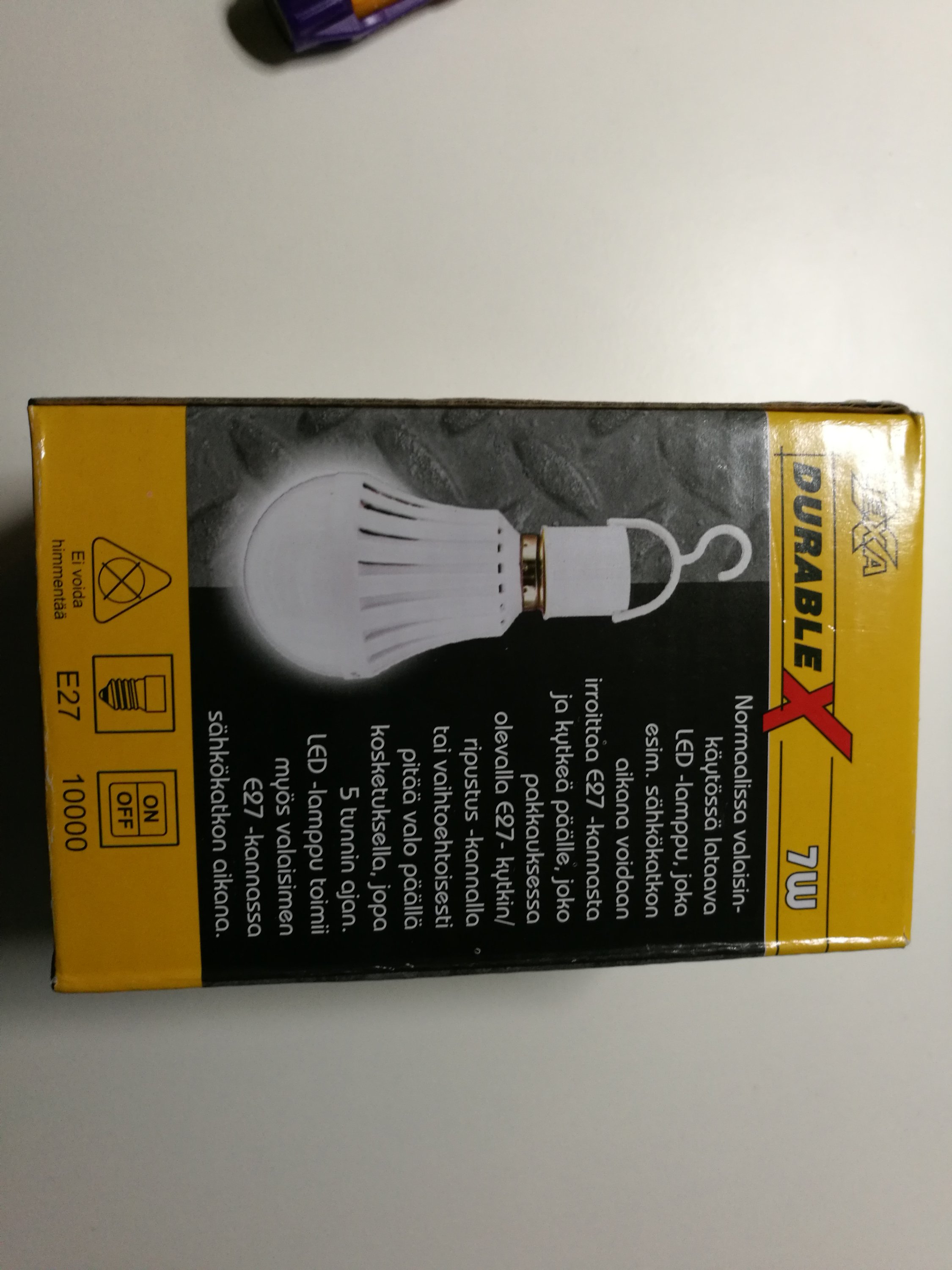
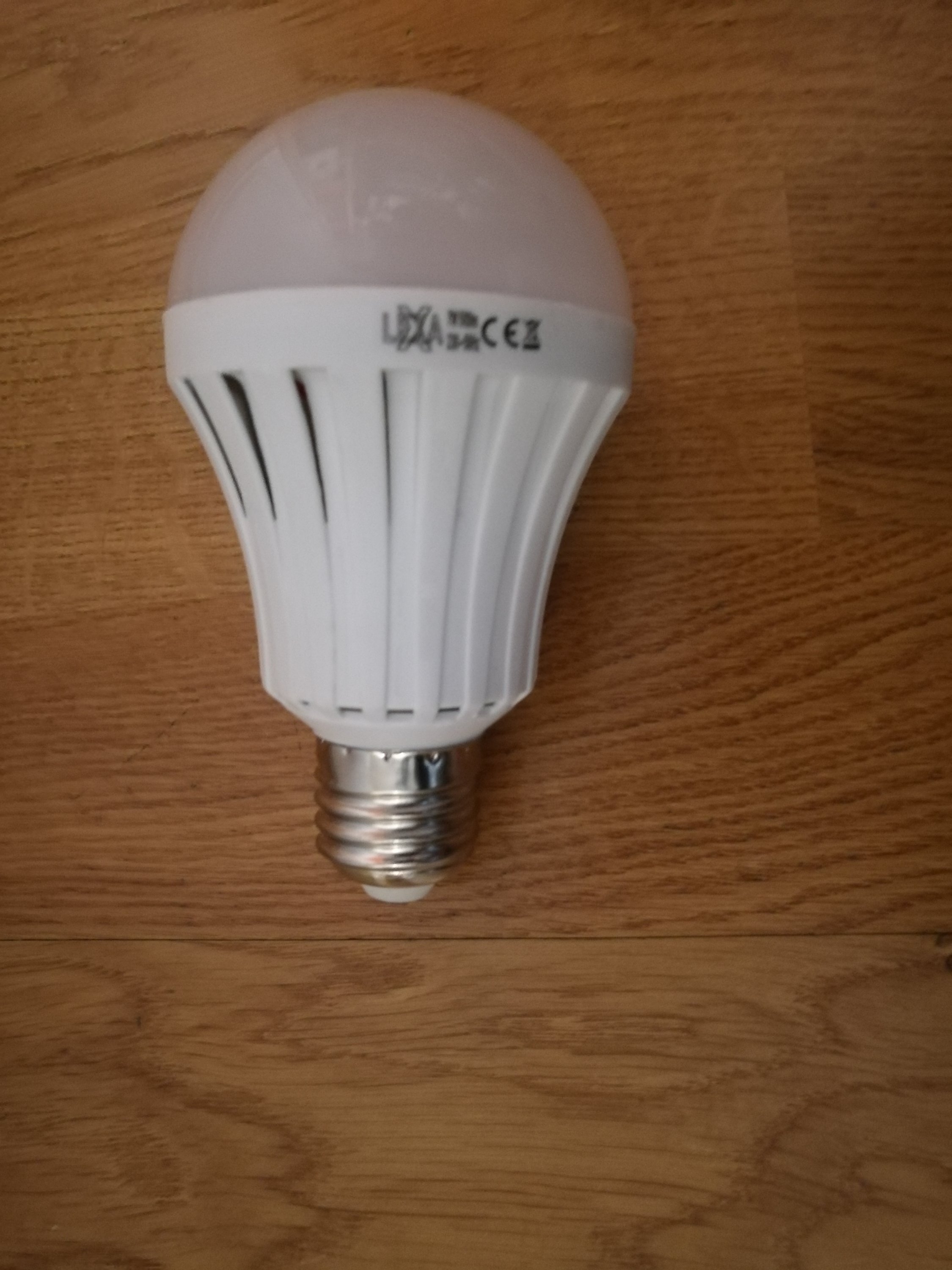
Here is technical data from product page translated to English:
- 230V 7W 500lm
- Li-on Battery 1200mAh
- Stock E27
- 65mm x 117mm
- Warm white 3000K
- Radius angle of 120 °
- 35000h
- It can not be dimmed
- Action time up to 5h
- Charging time 5-10h
- Including E27 switch / suspension strap
The idea sounds brilliant. The bulbs works nicely as normal LED bulb with mains voltage:
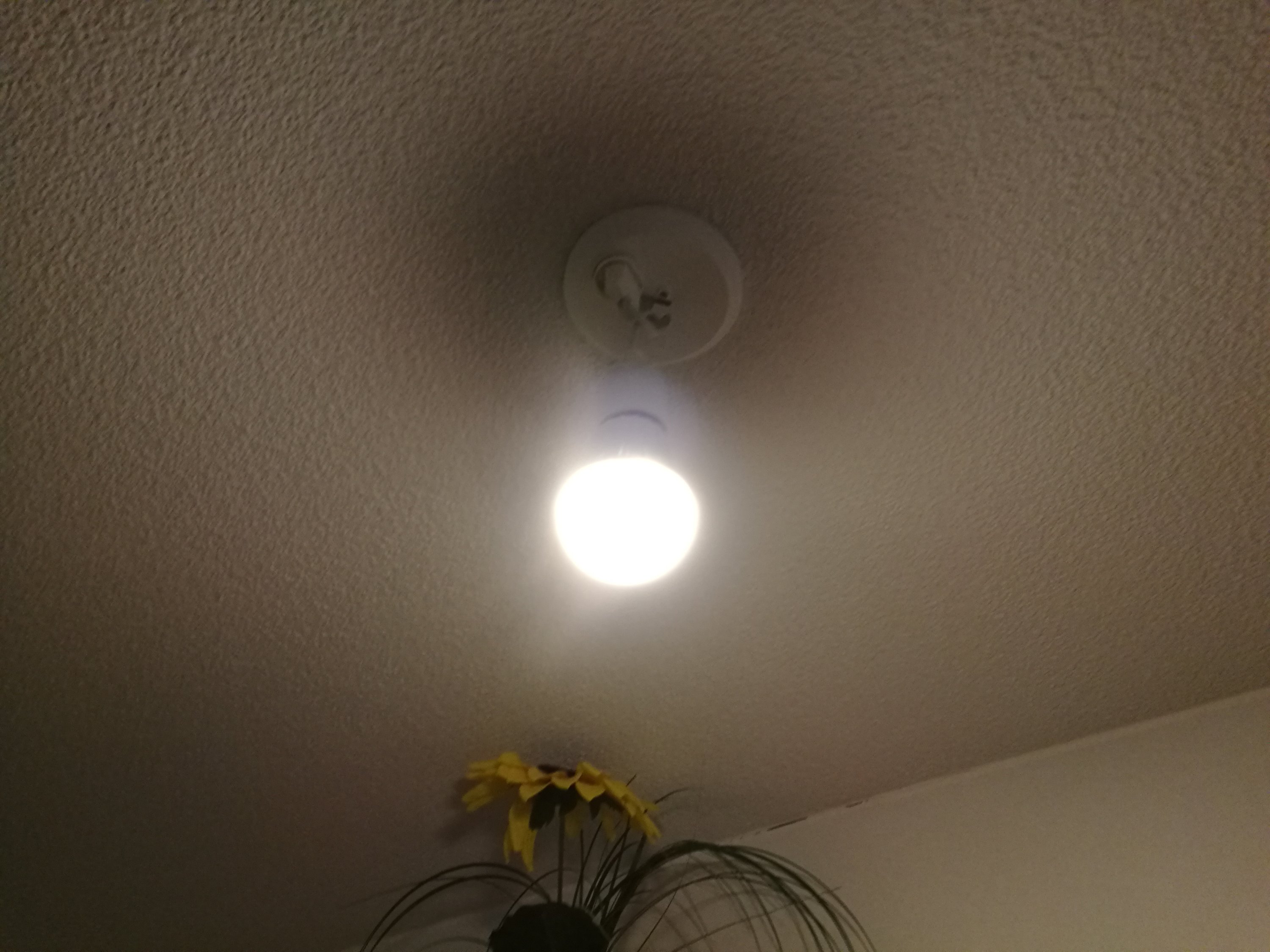
It gives out light (power from internal battery) when screwed with holder that come with the bulb:
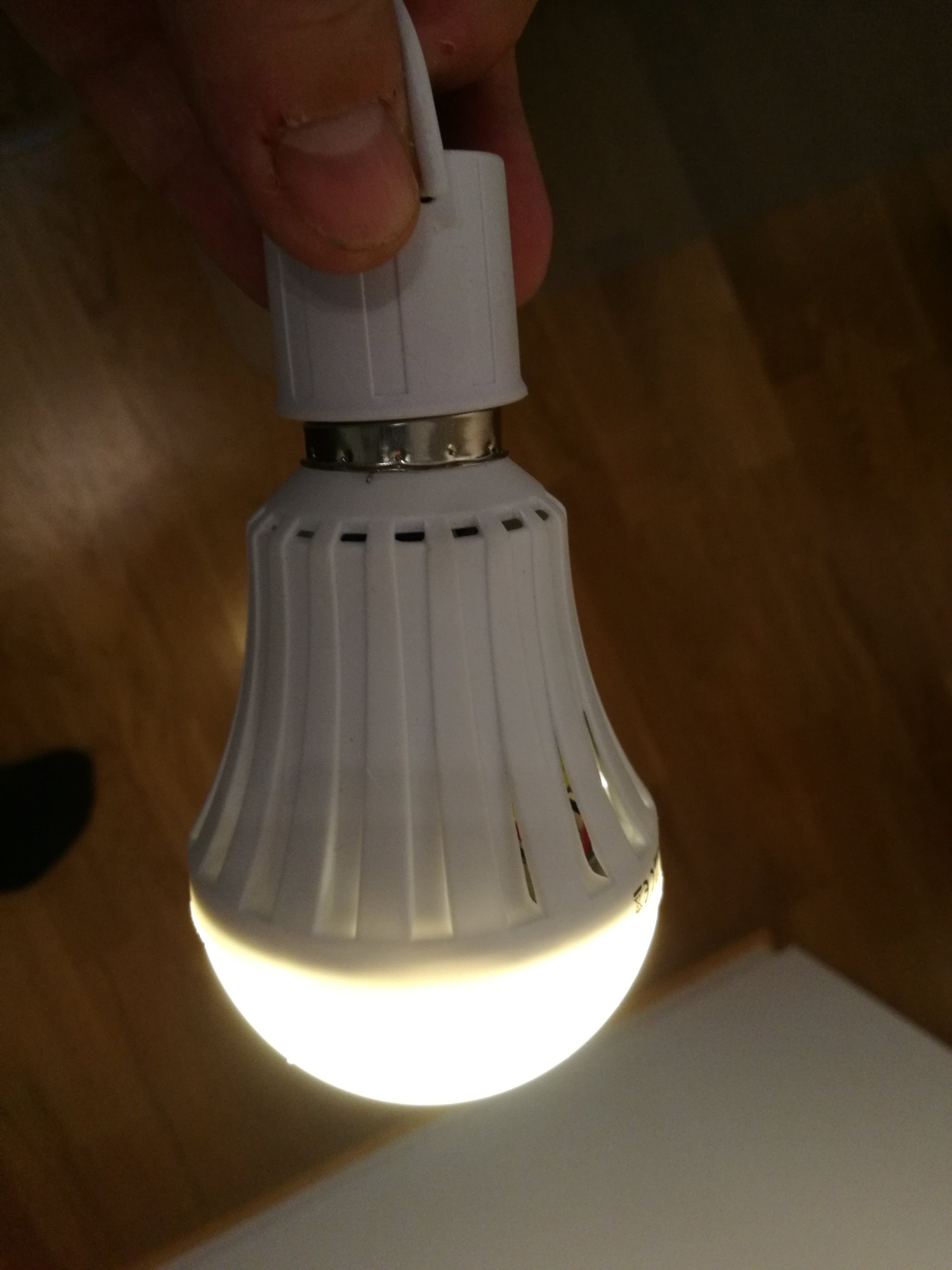
I could even turn o the bulb with my fingers!
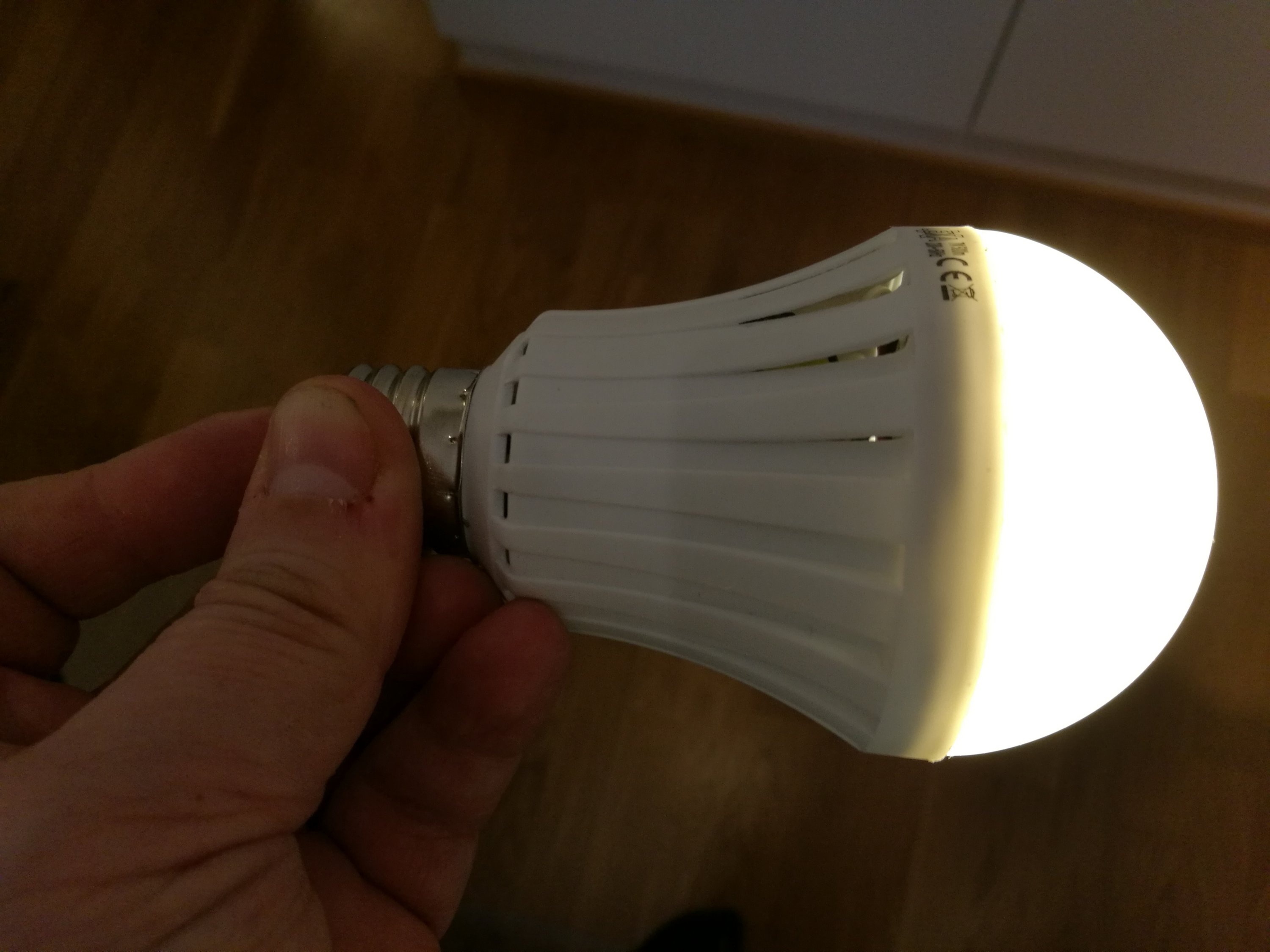
I did some measurements how the light bulb reacted to different loads between pins on the base:
When the resistance was from short circuit to 470 kilo-ohms, the bulb was fully on. When the resistance was one mega-ohms, the bulb gave some very dim light. With bigger resistance values, no light output.
I also measured that the bulb pushes out around 2.5V DC (open circuit voltage, plus on center of base) to the bulb base to try to detect if the light switch is closed or not. The output current is very low, about 3.3 micro-amperes to short circuit.
To this point good. Good idea, but it is failing on one big issue: it does not always reliably turn off when the light switch is turned off.
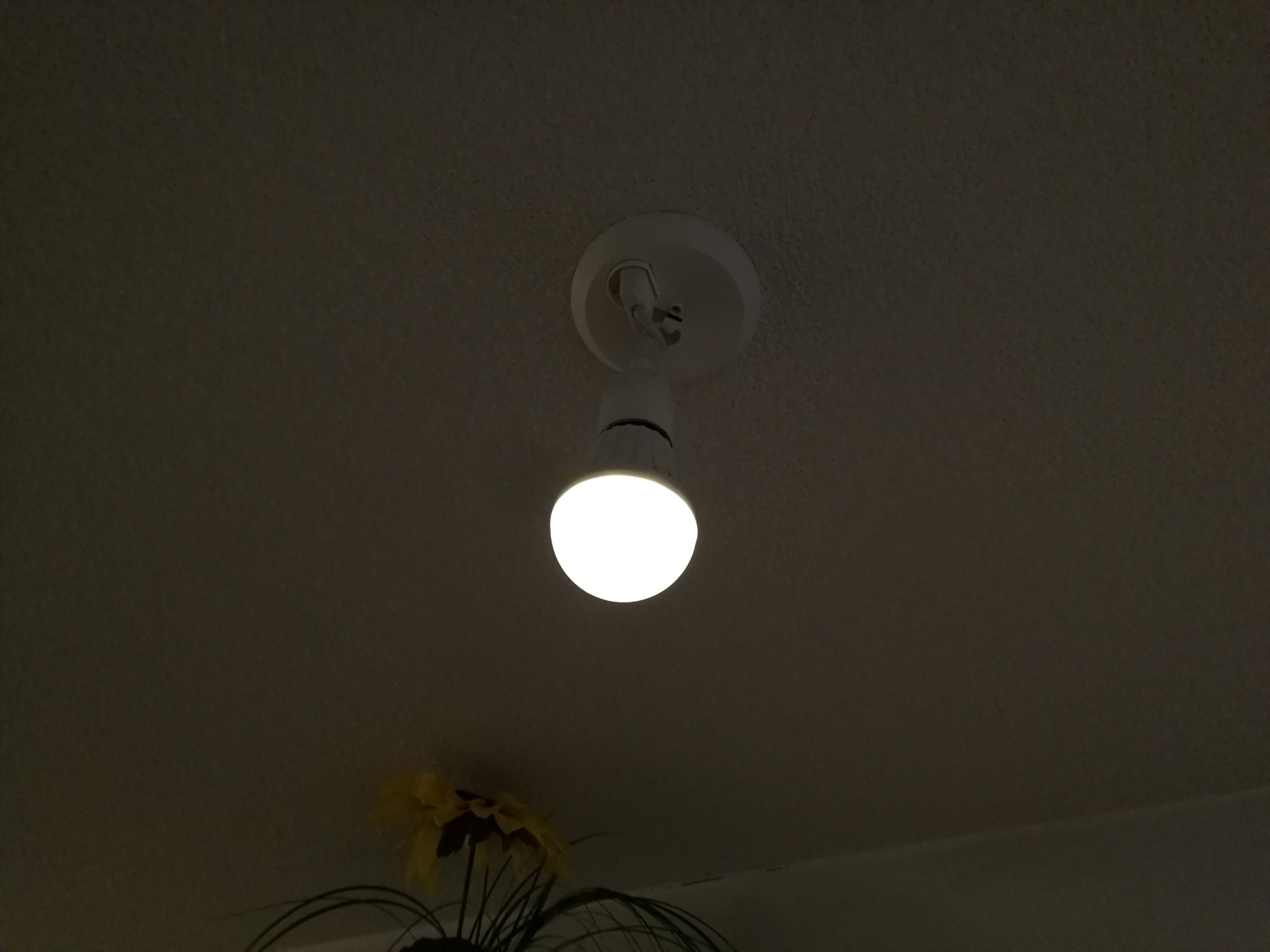
This is pretty annoying. When I want to turn off the bulb, it could turn sometimes off, sometimes does not turn off, sometimes gives some dim light then turned off. Very annoying and will use the stored energy (that should be there for emergency).
What causes this issue? I tried the bulb on several lamps with wall switches. Pretty much same results. And this was a new house I tested with wiring made well. No other load on those light circuits. Tested on two light circuits. Tested with two different bulbs. All this to eliminate that there was a single mistake (bad lighting circuit wiring or damaged product).
Then I took the bulbs to the lab and made some measurements. I tested ow the bulb reacted to AC frequency (50 Hz) signal coming from bulb base into bulb. I noticed when then AC voltage goes to around 3V RMS, the bulb turns dimly on (consumes power from internal battery) and then AC voltage reaches 3.5V RMS the bulbs turns fully on (to brightness it operated normally from internal battery). So this indicates that getting few volts of noise on incoming wire can turn the bulb on. I tried to measure the input resistance and capacitance of the bulb to low voltages: the resistance seems to be infinite to several mega-ohms and capacitance was 27 pF. At this high impedance input on the bulb to sense something, it is no wonder that it can pick up few volts of noise on floating mains wires in mains wiring bundle. This product does not seem to have robust enough design for reliable operation in real-life use cases I have.
I was not satisfied with the results. Those bulbs are not very useful to me. Not completely useless (they work as flash lights), but not very useful. If those were built with more robust detection circuit, those builds could have been very good.
Verdict: Not recommended because bubs fails to often turn off properly when it should.
Question: Are there any better similar products on the market that do well what they promise? (Free samples for testing are well-come for review)
10 Comments
Tomi Engdahl says:
Interested on the tear-down of this type of lamp?
bigclivedotcom has made a video of it:
Inside an “intelligent” emergency lamp with schematic.
https://www.youtube.com/watch?v=rcKbLnUz1bI
I have to admit that this is a very clever idea. It’s a standard LED lamp with the addition of a lithium cell. In normal use it charges from the mains while lit, but in the event of power failure it will light up automatically, but only if the wall switch controlling that light is on. That basically means you can turn it on and off from the light switch even when there’s a power cut. It does this by applying a small DC voltage to the lamps contacts and detecting if it is bridged. If the wall switch is off then no significant current will flow, but if it is on then current will flow through other appliances and circuits in the house and it will detect that and light.
This does mean that it can only really be used in a single lamp holder on its own, and the switch can only be a simple one with no active electronics.
Tomi Engdahl says:
A look inside a 1W LED emergency light.
https://www.youtube.com/watch?v=kKyF-bwo1k0
The video also has my take on the cheapest and possibly tackiest Chinese style emergency light circuit possible. Like a challenge to design an emergency light with the minimum amount of components possible.
But in my last-minute addition there’s a design flaw. With the LED in series between the switching circuit and the cell, the voltage available to turn on the transistor would be so low that it would probably allow the LED to glow, but not light fully.
Tomi Engdahl says:
Neat idea but one slight drawback if this lamp was used in a room with more than one lamp fitting on the same switched circuit. When the power is turned off the emergency light would come on because the sense circuit would see the other lamp(s) in circuit as a dc path between the terminals.
Tomi Engdahl says:
Teardown: LED Bulb Yields Tiny UPS
https://hackaday.com/2018/04/23/teardown-led-bulb-yields-tiny-ups/
Occasionally you run across a product that you just know is simply too good to be true. You might not know why, but you’ve got a hunch that what the bombastic phrasing on the package is telling you just doesn’t quite align with reality. That’s the feeling I got recently when I spotted the “LED intellibulb Battery Backup” bulb by Feit Electric. For around $12 USD at Home Depot, the box promises the purchaser will “Never be in the dark again”, and that the bulb will continue to work normally for up to 3.5 hours when the power is out. If I could repurpose that to make a tiny UPS for a microcontroller project of my own, it could be even more useful.
Now an LED light bulb with a battery in the base isn’t exactly rocket science, we can understand the product conceptually at a glance. But as they say, the devil is in the details.
The bulb drops down to 200 lumens when in battery backup mode,
we can be fairly sure it will contain two separate arrays of LEDs: one low set for battery, and a brighter set to run when the bulb has AC power.
As expected, there are two concentric rings of LEDs in the array which turn on or off depending on whether the bulb is on AC or DC power.
The white connector on the top side of the board connects to the 3.7V 2000mAh battery, which incidentally takes up most of the internal volume of the bulb.
Interestingly, the circuitry in the bulb is sensitive enough that if you hold the bulb in your bare hand it will see it as an unpowered circuit and light up.
Worth It?
There’s some decent hardware in the bulb that might be worth the cost of admission, especially when these bulbs invariably hit the clearance section for $6 or so. The dual-brightness LED array and relatively beefy battery can be easily repurposed, for a start.
Tomi Engdahl says:
Teardown: LED Bulb Yields Tiny UPS
https://hackaday.com/2018/04/23/teardown-led-bulb-yields-tiny-ups/
Investigating the Tiny Salvaged UPS from a Lightbulb
https://hackaday.com/2018/05/21/investigating-the-tiny-salvaged-ups-from-a-lightbulb/
Tomi Engdahl says:
Inside an “intelligent” emergency lamp (with schematic).
https://www.youtube.com/watch?v=nnXkQmswNJ4
Although I’ve featured this style of lamp in the past I’ve never done a full reverse engineer of the most common type. So here it is. It’s one of those products that achieves economy through clever tricks that take a moment to get your head around.
So look for listings where they show someone bridging the cap with their fingers or with the screw-on switch cap to use it as a rechargeable work light.
Tomi Engdahl says:
Crappy lead-acid LED lamp with brilliantly simply circuitry.
https://www.youtube.com/watch?v=sax9unx76Kg
This version of the now classic “intelligent emergency lamp” has the most minimalist circuitry seen yet, and what appears to be an SLA (Sealed Lead Acid) battery. In one area it has cut cost a bit too much and in another area it is fiendishly clever in using just a single transistor in its active circuitry.
Comment:
“This is exactly what my lamp circuitry was like… but mine uses 18650 cell without protection instead. That SLA battery is very common in cheap Chinese flashlight or mosquito racket because they’re cheap and don’t require protection to charge, they usually just get charged by a capacitor dropper like that but I haven’t seen one venting or oozing out electrolytes though.”
Tomi Engdahl says:
SRS Fenno El Oy Joka paikan varavalo LED 7W Full HD
https://www.youtube.com/watch?v=G6Pl9tjpqME&feature=emb_logo
Ladattava E27-kantainen 7W LED-lamppu. Soveltuvuus: turvavalo, taskulamppu, telttavalo, terassivalo, yleisvalo, työvalo. Lataa lamppu normaalissa E27-kantaisessa valaisimessa, ja käytä latauksen jälkeen jopa viisi-tuntia. Sähkökatkon sattuessa, voit käyttää lamppua normaalisti valaisimen kytkimen kautta.
https://kauppa.srsfennoel.fi/lexxa-led-lamppu-e27-7w-230v-akku-1200mah.html
Tomi Engdahl says:
Crappy lead-acid LED lamp with brilliantly simple circuitry.
https://www.youtube.com/watch?v=sax9unx76Kg
This version of the now classic “intelligent emergency lamp” has the most minimalist circuitry seen yet, and what appears to be an SLA (Sealed Lead Acid) battery. In one area it has cut cost a bit too much and in another area it is fiendishly clever in using just a single transistor in its active circuitry.
I just had to take the lead acid battery apart to see what was inside. Mainly lead and acid apparently. Quite a lot of lead too – I guess they have to get rid of all that lead somewhere.
Tomi Engdahl says:
https://etn.fi/index.php/new-products/12753-eatonin-mini-ups-varmistaa-verkkoyhteydet-kotona